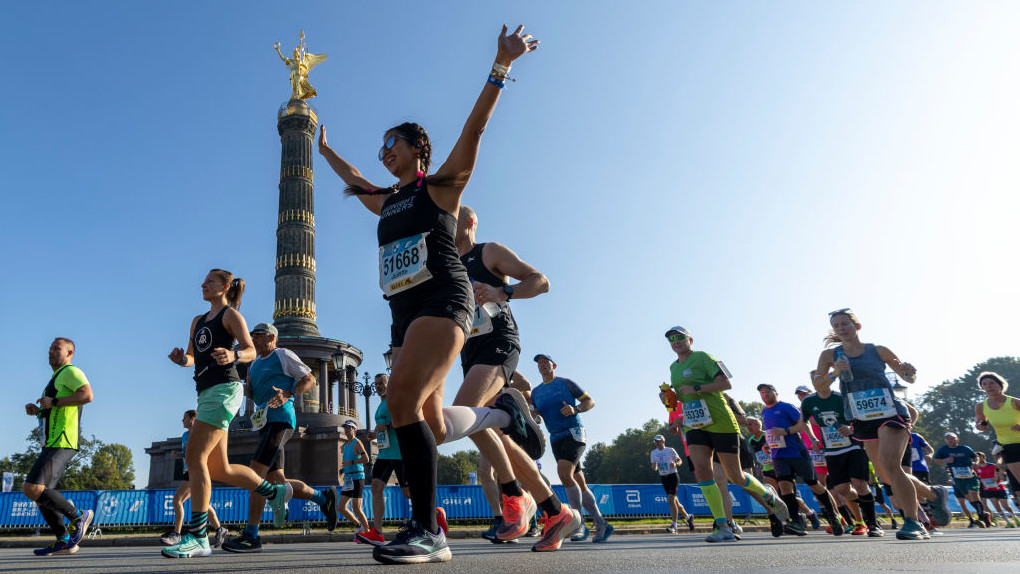I Ran 2hr 28min At The Berlin Marathon Last Year—Here’s My Strategy For The Race
The flat, fast course makes the Berlin Marathon perfect for nailing a race plan and grabbing a PR

The Berlin Marathon is the perfect race for setting PRs. Its famously flat and fast course has been the setting for the last eight world record times in the marathon, a streak that goes back to 2004.
In 2022 Eliud Kipchoge set the world record at the Berlin Marathon, an incredible 2h 1min 9sec. I wasn’t exactly hot on his heels, but I did clock 2hr 28min 34sec to finish 146th at the race, and while you’d probably rather get Kipchoge’s advice than mine, he has other things to think about this week since he’s racing Berlin again, so you’re stuck with me.
The overall elevation of the Berlin marathon course is low and it’s also consistently flat. The one spike on the elevation chart, which comes at around the 16-mile mark, is barely noticeable when running, at least in my experience. This allows you to create a strict race plan and stick to it, more so than with other marathons that have more ups and downs—even the London Marathon has more noticeable hills that can throw you off.
If you don’t have a plan already, that’s probably not great news given that it’s race week, but don’t despair because you can borrow mine. Here are three things I did in Berlin that I’d do again, and one I wouldn’t.
I Ran 3km Splits
Berlin has a lot of long straights and there are several points where you’ll tick off a few kilometers without making a turn. Given that, I found I liked having longer splits of 3km set up on my watch, where I could hit a target pace for that period and try to switch off and relax in between beeps, rather than looking out for each kilometer marker. You could go for 5km splits, but that’s a little too long to wait for a lap in my mind, and 3km neatly splits the marathon up into 14 laps.
It’s also a more open marathon than many city events, so my GPS accuracy was pretty good over a 3km stretch. I also didn’t feel the need to “correct” the distance by manually splitting at each kilometer marker, which I do during the London Marathon, especially around Canary Wharf.
I Started Slower Than My Goal Pace

Running a negative split—where you run the second half faster than the first—is generally considered a smart way to pace a marathon, and Berlin’s flat course is the perfect place to do it.
Get the Coach Newsletter
Sign up for workout ideas, training advice, reviews of the latest gear and more.
On the advice of my coach, I used the first 9km of the race to slowly ramp up my pace until settling into my goal pace from 10km, which allowed me to speed up again from halfway until the last 5km, when I was able to hold on. I ran 1hr 14min 41sec for the first half then 1hr 13min 53sec for the second, and felt in good shape deep into the race.
A slow start is always daunting because you lose seconds on your target time and that feels terrible when you know you could be running quicker. But if you stick with it, you’ll make that time back and then some by running a negative split.
I Consumed A Lot Of Carbs
I aim to consume around 60g of carbs per hour during a marathon, which in Berlin I did using Maurten 320 sports drink mix and gels. In the morning before the race I had 500ml of the drink mix, which is 80g of carbs, along with some bread for breakfast.
Then in the race I carried three 250ml soft flasks of the drink, each bottle containing 40g of carbs, plus two Maurten gels, each giving me 25g of carbs. Every 5km I’d have either half a bottle or one of the gels, so I was consuming some carbs up until 40km, and took in 170g in total during the run on top of what I had pre-race.
I’ve used this strategy for several marathons and while carrying your own drinks is a faff, if you have a good set of shorts with waist pockets or a running belt, it works fine and once you’ve had half of each bottle, they don’t feel particularly large in a pocket in my experience. I also find a high-carb drink is easier for me to stomach than the large amount of gels you need to hit 60g of carbs per hour.
I Was Almost Late To The Starting Pen
Something to avoid at the Berlin Marathon! The bag drop and toilets at Berlin are quite a long way from the start pen I was in, and there was a very narrow entrance to the pen which meant a big crush of runners trying to get through as the minutes ticked down towards start time. I got into my pen just a couple of minutes before the start, which was extra stress that no-one needs on marathon morning, so bear in mind you’ll have a walk to the start after dropping your bag.
To ensure you arrive at the start completely prepared for the race, make sure you read this Berlin Marathon guide.
Inspired to enter next year's race? We've got everything you need to know about marathon training, from a sub 3-hour marathon training plan to the best marathon running shoes.

Nick Harris-Fry is a journalist who has been covering health and fitness since 2015. Nick is an avid runner, covering 70-110km a week, which gives him ample opportunity to test a wide range of running shoes and running gear. He is also the chief tester for fitness trackers and running watches, treadmills and exercise bikes, and workout headphones.
